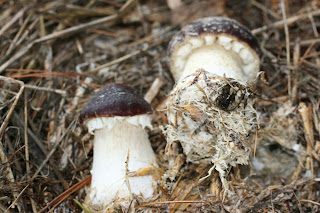Hors d'oeuvres Recipe Contest
by Field & Forest Products
If you grow (or love to cook with) Shiitake, Oyster, Lion’s Mane or Wine Cap mushrooms, we bet that you've been asked to "bring something with mushrooms" for a potluck or hors d'oeuvre party. We also bet that many of you have developed or adapted some delicious recipes for those occasions. Enter your favorite mushroom hors d'oeuvres recipe to share with our mushroom growing community for this upcoming holiday season! Our contest is open to hot or cold mushroom hors d'oeuvre recipes using fresh, dried or frozen Shiitake, Oyster, Wine Cap, Lion’s Mane or Comb Tooth mushrooms (or any combination thereof). Entrees will be judged based on their originality, ease of preparation, and taste by Chef Janice Thomas from the Savory Spoon Cooking School in Ellison Bay, Wisconsin.
The Grand Prize winner (1) will receive an 8-Block Starter Set, mix or match.
Second (1) and third place (1) winners will each receive a Table Top Farm of their choice.
F&FP reserves the right to publish all contestant recipes (with credit given, of course) on social media and in print.
To enter, send us your recipe by email to info@fieldforest.net or snail mail to Field and Forest Products, N3296 Kozuzek Rd., Peshtigo, WI 54157. Please include your name, address, and phone number. If you have any questions, please email us at info@fieldforest.net or call us at (800)792-6220. Submission deadline is November 1, 2016. Winners will be announced via Facebook, your email (if provided), and our website, www.fieldforest.net on December 1, 2016.
If you do not wish to enter the contest yourself but would like to see the winning recipes, please check our website on December 1 or see our post on Facebook that day. You can also send us your email address to receive the winning recipes in our December Newsletter.
SHIPPING RESTRICTIONS: FREE UPS standard ground shipping of all 8 blocks (Grand Prize) to be shipped all at once in a single box to a single destination within the lower 48 states only. Mix of blocks in the set may vary depending on requested ship date and available inventory of your block selection. SECOND & THIRD PRIZES: FREE shipping within the lower 48 states only. Preferred ship date can be specified by customer. Ship date is dependent on available inventory.
About our Judge
Chef Janice has over 20 years of experience in the food industry and has owned her own catering company for the last 14 years. Janice also owns and operates the Savory Spoon Cooking School in Ellison Bay, Wisconsin, which hosts weekly cooking classes May through October on a variety of cooking subjects and styles. Janice has been teaching cooking classes for many years in Arizona, Oregon and Wisconsin. Studies at the renowned Cordon Bleu in Paris and with well-respected chefs in France, Italy and China have enhanced Janice's repertoire. We are very excited that she agreed to judge our contest and look forward to her preparing one of the winning recipes in her yearly mushroom cooking class in 2017. For more information on Chef Janice’s classes, culinary tours and her special Panforte, go to www.savoryspoon.com
The Grand Prize winner (1) will receive an 8-Block Starter Set, mix or match.
Second (1) and third place (1) winners will each receive a Table Top Farm of their choice.
F&FP reserves the right to publish all contestant recipes (with credit given, of course) on social media and in print.
To enter, send us your recipe by email to info@fieldforest.net or snail mail to Field and Forest Products, N3296 Kozuzek Rd., Peshtigo, WI 54157. Please include your name, address, and phone number. If you have any questions, please email us at info@fieldforest.net or call us at (800)792-6220. Submission deadline is November 1, 2016. Winners will be announced via Facebook, your email (if provided), and our website, www.fieldforest.net on December 1, 2016.
If you do not wish to enter the contest yourself but would like to see the winning recipes, please check our website on December 1 or see our post on Facebook that day. You can also send us your email address to receive the winning recipes in our December Newsletter.
SHIPPING RESTRICTIONS: FREE UPS standard ground shipping of all 8 blocks (Grand Prize) to be shipped all at once in a single box to a single destination within the lower 48 states only. Mix of blocks in the set may vary depending on requested ship date and available inventory of your block selection. SECOND & THIRD PRIZES: FREE shipping within the lower 48 states only. Preferred ship date can be specified by customer. Ship date is dependent on available inventory.
About our Judge
Chef Janice has over 20 years of experience in the food industry and has owned her own catering company for the last 14 years. Janice also owns and operates the Savory Spoon Cooking School in Ellison Bay, Wisconsin, which hosts weekly cooking classes May through October on a variety of cooking subjects and styles. Janice has been teaching cooking classes for many years in Arizona, Oregon and Wisconsin. Studies at the renowned Cordon Bleu in Paris and with well-respected chefs in France, Italy and China have enhanced Janice's repertoire. We are very excited that she agreed to judge our contest and look forward to her preparing one of the winning recipes in her yearly mushroom cooking class in 2017. For more information on Chef Janice’s classes, culinary tours and her special Panforte, go to www.savoryspoon.com







